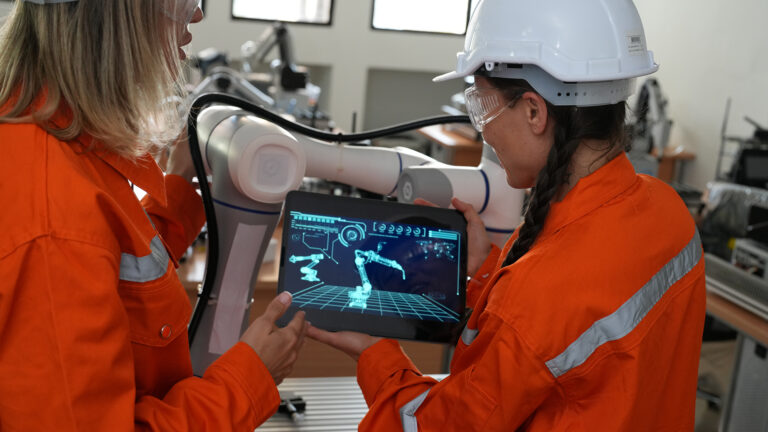AI is a branch of computer science that simulates human intelligence through the processing of very large sets of data. It is being implemented in economic, social and technological sectors, and the telecommunications sector is no exception.
It is developed through data collection and analysis. Through algorithms and mathematical methods, AI can extract patterns that can then simulate human intelligence. The more data you enter and the more varied it is, the more information you will have to generate more effective solutions.
AI improves the performance of many traditional processes, which is why several companies are implementing it to improve the quality of their products and services.
AI uses different techniques, some of which are briefly described below:
Machine learning (ML)
ML is a branch of machine learning. Through this technique, using classical algorithms and models, computers are trained and "learn". The data is processed logically and certain patterns are identified that cause the "intelligence" to be generated. This technology uses classical techniques, such as linear regression, for example.
Deep learning (DL)
DL is a subcategory within machine learning. It consists of the deepening of machine learning: more sophisticated tools are used, such as artificial neural networks, which generates better results.
Uses of AI in telecommunications
Let's take a look at some of the possible applications of AI in the telecommunications area.
Network monitoring and management
Users and traffic are growing, and telecommunications networks have become more complex. Therefore, improving network management and efficiency has become a priority for all telecommunications company operators.
AI has a fundamental task in analyzing problems in the network and can generate improvements, preventing problems before they happen, in an automated way.
For example, Orange engineers in France created a system, based on AI, that anticipates 30 minutes in advance of a communications network congestion by predicting the evolution of several parameters or performance indicators. It has an 80% success rate and allows them to prevent problems, saving time for those who manage the network.
"We usually consider performance indicators individually. With this artificial intelligence solution, we move to considering the impact of several variables at the same time," says Sylvain Allio, one of Orange's engineers.
As Sylvain says, AI allows us to have a better sense of the network than we had before. When we predict that there will be a problem in the network, we focus on the equipment that is causing the problem or on neighboring equipment. Thanks to AI, not only can we predict future problems, but we can also identify the elements that cause them, which allows us to anticipate and avoid them before they happen.
Network energy consumption and efficiency
In addition to monitoring or improving network management and stability, another application of AI in telecommunications networks is to improve network energy efficiency.
By taking data on network consumption and the capacity delivered to customers, using AI techniques it is possible to assess network efficiency and take action if necessary. In this regard, Orange has also committed to reducing its carbon footprint emissions by 30% by 2025, something it plans to achieve using AI.
Ericsson also applies ML techniques to save energy. Thus, they manage the power saving mode of radio transmitters when it is predicted that user traffic will be below a certain value. This technique, using ML, generated a 14% saving in energy consumption at each site, surpassing manual management.
AI threat detection
Another issue that is becoming very prevalent in telecommunications networks is cybersecurity. Nowadays it is very important to be able to detect threats in time and thus protect customers' confidential information from digital attacks.
Many companies have been able to address these attacks using methods powered by automation, AI and machine learning. This has helped them detect suspicious activity more effectively and in real time.
AI makes it possible to detect insiders, suspicious IP addresses and malicious files in a matter of seconds. AI's continuous learning and the amount of data it collects facilitates the identification of security threats and reduces detection and attack time.
For example, Nokia has created a software-based system called Deepfield Defender. This software uses an updated data source, called Deepfield Secure Genome (patented by Nokia), which takes information from the internet (IP addresses, internet traffic) and with AI techniques classifies and divides these flows into different security categories. This data source knows previous attacks and servers that are insecure. With this information and other information obtained from the network, Deepfield Defender can detect DDoS-type attacks more quickly.
What are these incidents about? DDoS (Distributed Denial of Service) is an attack directed at a specific network, server or service. It saturates the target network, including the server or service that composes it, through a flood of Internet traffic coming from distributed sources, but coordinated by the attacker. This causes a significant disruption in the normal traffic of the affected network.
Improved user experience
Telecom operators can also use AI to improve user experience.
Based on customer data, operators can apply AI to detect customer preferences and offer personalized services. For example, trends can be identified and consumption patterns can be predicted using AI to recommend a certain commercial package to the user or customer, taking into account their present or future needs, with different connection speeds or call quality.
AI: a differential for the industry?
As telecommunications networks have more and more users and traffic, it is essential to have tools to monitor, improve their efficiency, prevent attacks and retain customers.
Algorithms for network management, to improve energy efficiency or to make networks more secure and provide better services to customers are just a few examples of the many applications that AI could have in telecommunications networks, making them more stable, secure and sustainable.
Therefore, the application of AI can be key for telecommunications operators as a way to improve the quality of service and the vision of their customers, and will be in the future a differential when choosing an operator or a brand.



